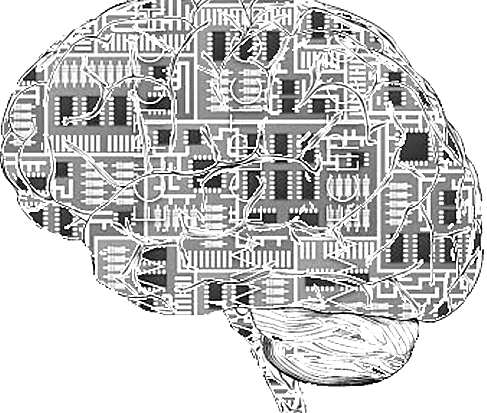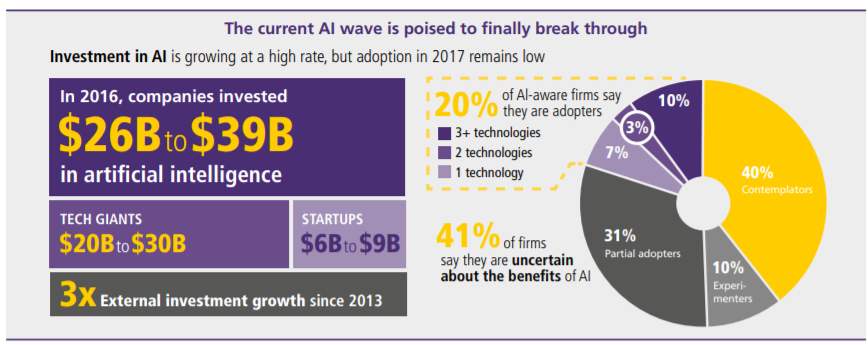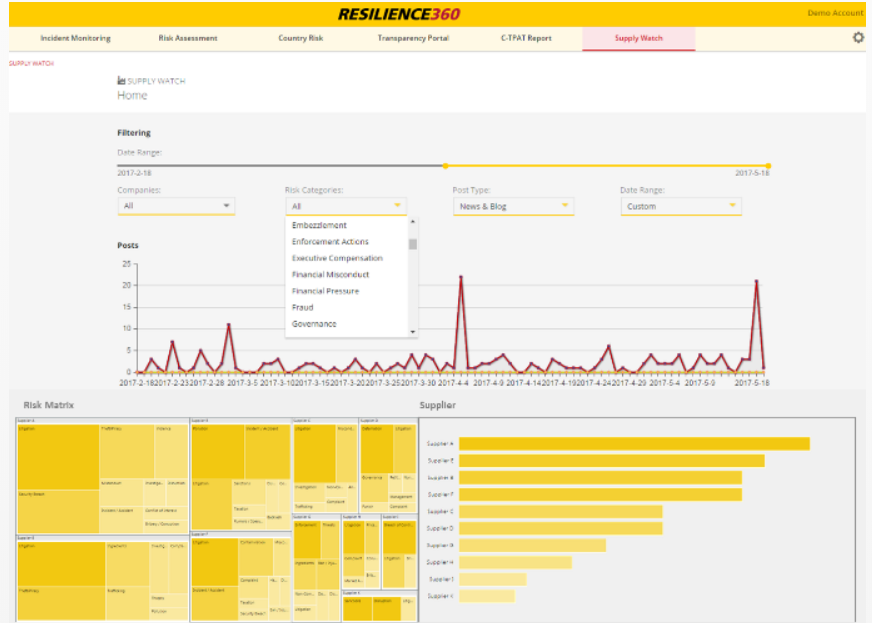
For the past several years, machine learning as evolved by the hyperscalers has been trickling down from on high, through frameworks and services, into enterprises.
Machine learning is becoming a regular technique underpinning applications in a growing number of industries like manufacturing, energy, telecommunications and engineering, where companies see it as a way to not only reduce the costs and improve the efficiencies in their operations but also to more quickly detect patterns in and gain insights from the huge amounts of data they are generating. The goal is to making better and faster business decisions, and to make more money.
We have talked a lot here at The Next Platform about the growing use of AI in research and business and have touched on its potential in the logistics industry. A report by DHL and IBM released this week indicates that while investment in AI is growing rapidly, numbers from last year showed that adoption among commercial businesses is still slow. According to the numbers shown below, companies in 2016 invested $26 billion to $39 billion in AI, but that in 2017 only 20 percent of AI-aware firms said they were adopters. Some 40 percent were “contemplators” while another 31 percent were partial adopters.
However, AI is becoming akin to a force of nature in a business world, according to Ben Gesing, project manager in trend research in DHL’s Innovation and Trend Research Division.
“The world is going through a huge transformation, similar to the agricultural revolution and the Industrial Revolution,” Gesing tells The Next Platform. “The digital revolution is upon us and AI is a very big part of that transition. What’s happened in recent years is that AI has come flying out of the research laboratories to become ambient and ubiquitous in our personal lives, so much so that for consumers like you and me, if you used Google or Facebook this morning, you’re using an average service that contains machine learning, that contains AI on a daily basis and you probably don’t even know it. Things that become ubiquitous in the consumer world begin showing up when we bring them into work with us in the enterprise and then they show up in the industrial sector. DHL is sort of in those latter two, so for that reason the current state of adoption really bodes for a future of really widespread use in logistics.”
DHL is a massive $60 billion company with more than 500,000 employees around the world that is best known for its international express business but also has deep expertise in e-commerce, supply chain services, and global air and ocean freight forwarding services. The company also has its Trend Research business, which takes a look at what’s on the horizon five to ten years down the road in both social and business as well as technology, such as robotics, automation, augmented reality, and the Internet of Things IoT. AI is a key part of the trends in technology in the logistics industry, which is primed for the technology, Gesing says. It’s still in the early stages: IBM researchers in the report said that only about 10 percent of systems, data and interactions include elements of AI analysis and results, but that returns on investments into AI are improving, and that as more AI is used in increasingly complex environments, that results from AI analysis will continue to improve.
In the logistics industry, “we have lots of operational data and we are inherently a network-based business, so the combination of all the data we have and the global footprint, AI has the opportunity to optimize the digital side and orchestrate the management of those networks to the degree that human thinking and traditional IT systems simply can’t achieve,” Gesing says. “The use of enterprise AI is still pretty limited and in many companies there’s lighthouses being set up and small data science teams and I don’t think logistics is an exception there.”
At DHL, there are a broad array of projects big and small underway that are using AI, machine learning and deep learning to help the company become more proactive, predictive and autonomous, and to change its services from standardized to more personal. One such initiative is Resilience360 (below), a cloud-based supply chain risk management platform designed to give customers are more complete view of their business operations, from tracking shipments to monitoring events that threaten to disrupt supply chains. A module within Resilience360 is Supply Watch, which uses machine learning and natural language processing algorithms to analyze a disparate array of data to detect potential supplier issues. The module analyzes , including by analyzing up to 8 million online posts every day in more than 300,000 online and social media sources to identify problems that could show up in a company’s supply chain.
“When we think of large automotive companies, large engineering and manufacturing companies, they have very fast networks of suppliers for all the different parts they need, and what we can do is we can use tools like [IBM’s] Sentiment Analysis to understand how employees or people at different parts of the world are talking about a certain supplier or certain site to understand if there’s tones of unrest or dissatisfaction,” Gesing says. “We can identify potential labor disputes or poor practices at a certain supplier ahead of time to proactively plan our downstream supply chain in a more efficient way. That’s where we’re actively using machine learning to understand how people talk about risk in certain situations.”
Another AI-based tool is DHL’s Global Trade Barometer, which launched in January and is designed to ingest massive amounts of data, such as import and exports levels for early to mid-stage commodities for several different countries, and then using AI algorithms factors in about 240 million variables around those countries. The technology can then match that against containerized ocean and airfreight shipment volumes. The indicator tool was developed by DHL and service provider Accenture.
“The output of all of this is we get a prediction of up to three months in advance of the global direction of how global trade will trend, so we’re really getting ahead of where global trade will be so we can drive other downstream activities to plan for that,” Gesing says.
DHL also is using machine learning technologies in parts of the company’s networks to help in other areas of prediction, such as determining delays in air freight by predicting the times of day or the days of the week or month that delays will most likely happen, or what airline carrier is most likely to have delays. This helps in predicting the arrival of shipments.
The company also is investing in a number of projects around autonomous vehicles. That includes using such vehicles in distribution centers and warehouses that can carry heavy loads and can navigate around people and obstacles to get from one point to another without having to follow pre-determined paths through strips or paint on the floor to guide them. It also is experimenting with semi-autonomous platoons of two to five trucks that are synchronized in their following distances, acceleration, steering and braking and can self-drive by following a lead truck with a human driver. The benefits to DHL are numerous: the company can get more freight to a lane, improve efficiency through wind drag and fuel consumption through synchronized braking. Next year, DHL and the British Transportation Research Laboratory will run a project with truck maker DAF Trucks in testing the platooning trucks in the United Kingdom.
“With an autonomous vehicle, there’s no way you can hard program every situation that it will experience into a software program, so in order for an autonomous driving to work, it has to self-learn,” Gesing says. “It has to use some kind of AI and continuous learning.”
DHL last year also began piloting a semi-autonomous robot called a PostBOT (below) that is designed to carry parcels and shipments and follow a mail carrier, saving the mail carrier from having to carry the packages themselves. The PostBOT is based on technology from a French startup called Effidence, which offers a robot used in warehouses that can carry heavy loads while following workers.
In addition, the company is growing its use of chatbots with machine learning algorithms to address customers in lower-level conversations and tasks, which Gesing explains frees up customer service representatives to deal with more complex situations. In addition, DHL is seeing other companies that use technologies like AI-driven recommendation tools driving more shipping business, and that conversational bots that use Alexa and similar technologies are enabling customers to ask those bots about their DHL packages. If the bot can’t find where the packages are, it can automatically route the customers to a DHL customer service representative.
DHL also is looking to leverage machine learning techniques to automate back-office processes.
“If you have, say, 100 people processing customers’ documents, we can offload some of that overhead to robotic process automation and different kinds of tools that use machine learning to automate some of that and what we do with those 100 people that were doing the processing, now becomes 100 people doing exception handling and handling the complex tasks,” he explains. “What we’re doing is increasing our throughput and increasing our capacity by a multiplier and not some incremental number, so that’s keeping with the same footprint, increasing revenue and lowering costs.”
It may be early in the adoption cycle of AI in enterprises and industry, but it’s an inevitable trend that will change the way business is done.
“The worst day for any AI system is the day it is implemented,” Gesing concedes. “That’s when they have the least training data, it’s when they have the least experience. AI is fundamentally a self-learning capacity, which means it gets much better over time, so you have something that today looks like it works well. That same system, if left relatively unchanged and that just perpetually learns as it gets exposed to more data, will give wildly different results and insights in five years. Overall, it’s an exciting future to think about.”








Be the first to comment